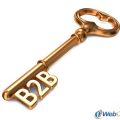The 2019 Best Practices for LinkedIn Content Marketing
For a B2B Content Strategy, Linkedin Can’t Be Beat!
Here’s Why…
Some of us in the B2B content marketing field, and we’re not naming names here, have been a little concerned about the utility of social media with regard to generating leads. With multiple changes to Facebook, Twitter, and Google+ algorithms, who can blame the worry, right? Organic reach has tanked, publishers are pouring money into campaigns that are return-on-investment negative, and data analytics graphs look like advanced Aspen ski slopes — going down!
But everybody, hold up! When it comes to a B2B content strategy there’s really no need to be concerned. We’ve been through these changes before, and like every other time, eventually, the platforms will correct themselves. In the meantime, really savvy markets know that connecting through LinkedIn can be a literal paradise for generating sales leads.
Some LinkedIn Facts and Figures to Consider
Did you know that LinkedIn now drives over half of all social traffic to B2B blogs and websites? According to recent research, the platform is estimated to produce almost 65% of all landing page visits to corporate websites! And while you can’t always trust statistics, something like 92% of B2B content strategists consider LinkedIn to be the most effective lead-generating web destination.
So, for 2019, the questions you should be asking yourself are:
- What are the best practices for LinkedIn B2B marketing?
- How does the LinkedIn algorithm work?
- And, um, do we even have a LinkedIn business page set up?
While one blog post can’t answer all these questions, let’s tackle the first and then figure out the next two over the coming week.
Seven Tips from IWC’s LinkedIn’s Cheat Sheet
- It’s all about quality content. No LinkedIn ‘cheat sheet’ can help if your posts don’t demonstrate a clear connection between your services and revenue on the client’s side.
- You don’t want to be too narrowly focused on sales, either. We think a nice balance is to publish content that’s about half about revenue, a fourth about your brand, and another fourth focused on ‘that human touch.’ You want your potential collaborators, clients, and the agencies you engage with to see you as a person, not a faceless corporate entity.
- Keep churning out that content. Whatever you’re posting to Facebook and Twitter, go ahead and publish a LinkedIn-tailored version as well. Whatever frequency you decide on, stay with it. We recommend once-a-day or three-times-a-week.
- Make sure that every employee (at least on the management team) has a page and is sharing your content with their connections. Make this a part of your standard operating procedure, like checking emails first thing every morning.
- Pay attention to the ‘Specialities’ section of your business profile. Add keywords relating to your business so it ranks as relevant in related search results.
- LinkedIn has massively-powerful search features. Take advantage of these to target potential clients and connect with them directly. Make friends! This is, after all, social media.
- Finally, don’t forget to analyze your engagements. LinkedIn, like Facebook and every other platform out there, has built-in tools for tracking who, what, when, where, and why. Deploy those on the weekly to refine your audience and increase your productivity. Nobody has time to dig around on any one single platform for three hours a day.
So What’s Next?
In our next couple of blog posts, we’re going to cover the LinkedIn algorithm and how to set up a basic company profile. In the meantime, why not check out our free reputation management tool and see who knows what about your business. It might just surprise you!







